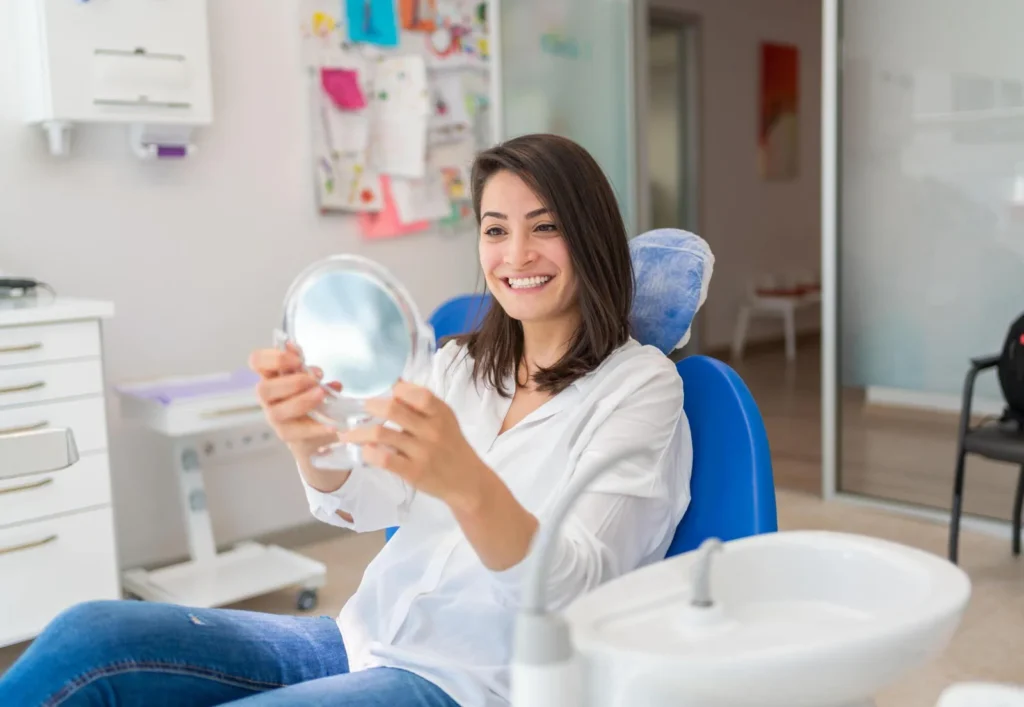Ever fancied a brighter smile that could light up a room? Many Brits are getting teeth whitening treatments. They hope to achieve just that. Among the myriad options available, LED lights have sparked a fair bit of interest. But do these snazzy bits of tech actually do the trick, or are they just a flash in the pan? Let’s shed some light on the matter, shall we?
How Teeth Whitening Lights Are Supposed to Work
The principle behind Teeth whitening Treatment lights, be they LED, UV, or halogen, is fairly straightforward. These lights are meant to speed up chemical reactions. The reactions are started by the whitening gel (usually hydrogen peroxide) that’s put on your teeth. The theory sounds promising. Hit the gel with the right light, and you could walk away with much whiter teeth in just half an hour.
The Light Fantastic: Types of Whitening Lights
- LED Lights: The most modern option, these emit a cool blue light and are favoured for their efficiency and safety. They don’t emit heat, which means less risk of causing discomfort.
- UV Lights: Once popular in dental offices, these have fallen out of favour due to potential risks, including damage to the mouth and gums.
- Halogen lights are known for their strong, useful light. They have been used for many dental procedures, including whitening.
The Shadow Cast: Skepticism and Science
However, not all that glitters is gold. Recent studies and reports from reputable bodies have done this. For example, the American Dental Association has done this. Research shows that teeth may appear whiter right after treatment. But, this is often due to temporary dehydration of the teeth. The dehydration reverses as your chompers rehydrate. Also, some studies suggest that the light itself doesn’t much help with whitening. The perceived benefits might actually come from the bleaching agents alone.
A Beam of Reality: What the Experts Say
Diving deeper, expert opinion tends to echo these findings. Many professionals argue that the success of whitening treatments lies in the quality of the gel and how it’s applied. They say it’s not the light that matters. In essence, the light helps in the best conditions. But, it is not the fix for dental discoloration.
Light at the End of the Tunnel: Safe Practices
If you’re still keen on giving these treatments a whirl, here’s how you can do so safely:
- Choose Wisely: Opt for treatments at professional dental clinics rather than home kits. Professionals are better equipped to handle and mitigate the risks.
- Follow Instructions: If using a home kit, adhere strictly to the instructions. Overuse can lead to tooth sensitivity and damage.
- Consult Your Dentist: Before deciding on any whitening treatment, have a chat with your dentist. They can provide personalized advice based on your dental history.
Brightening Up: The Verdict
So, do teeth whitening lights work? The answer isn’t black and white. While they might offer some benefit, the real heavy lifting is done by the bleaching agents. Lights may quicken the process, but they’re not essential for achieving a whiter smile.
Keeping Up Appearances: Aftercare and Maintenance
Whichever route you choose for teeth whitening, the journey doesn’t end when you step out of the dental clinic or switch off your home kit. Keeping those results requires a bit of nudge:
- Steer Clear of Stainers: For at least 48 hours post-treatment, avoid foods and drinks known to stain teeth—think coffee, tea, red wine, and dark sauces. This period is crucial as your teeth rehydrate and reseal.
- Daily Dental Diligence: Stick to a rigorous oral hygiene regimen. Brush twice a day. Also, floss and use an antiseptic mouthwash. These habits can help keep your teeth white and your dental health.
- Book follow-up appointments with your dentist. They are for cleanings and to check on the health of your whitened teeth.
Myth-Busting: Clarity in the World of Whitening
Let’s bust a few myths while we’re at it:
- More Light Equals Whiter Teeth: Not necessarily. As discussed, the effectiveness of light in teeth whitening is supportive at best and non-essential at worst.
- Whitening is Permanent: Sadly, no. Teeth whitening is temporary. Dietary choices, personal habits, and oral hygiene all play significant roles in how long your results last.
- Teeth Whitening is for Everyone: Not always the case. Some discoloration is caused by medication or injury. It might not respond well to standard whitening.
Final Thoughts
In conclusion, LED and other teeth whitening lights promise a bit of extra dazzle in the quest for a bright smile. But, they’re not the magic wand they’re often said to be. They do have a role, but it’s the bleach that does the bulk of the brightening. Lights might speed the process in some cases. But, they are not the key to getting those sought-after results.
So, the next time you’re looking to brighten up that beautiful smile, consider all your options, weigh the evidence, and talk to your dentist. With or without the lights, you can achieve a smile that’s not just brighter but healthier too. After all, a true smile shines not from the teeth, but from the heart. And that’s a light no technology can replicate. Cheers to a brighter, healthier smile, with or without the spotlight!
Keep Your Smile Bright with Old Town Dental Care
Just had your teeth whitened and wondering how to keep that glow? At Old Town Dental Care, we’re committed to helping you maintain your sparkling smile with expert advice and top-notch care. Whether you need guidance on post-whitening care or are looking to schedule your next appointment, our team is here to support your dental health journey. Don’t let your smile dim—contact Old Town Dental Care today and let us help you keep your teeth shining bright.
Frequently Asked Question
Do LED lights really make a difference in teeth whitening?
LED lights can accelerate the bleaching process but are not essential. The primary whitening agent is still the hydrogen peroxide in the gel.
Is teeth whitening with LED lights safe?
When used correctly under professional guidance, LED teeth whitening is safe. However, improper use can lead to sensitivity and gum irritation.
How long do the effects of LED teeth whitening last?
The effects vary but typically last from six months to two years, depending on dietary habits and oral hygiene.
Can I use LED teeth whitening if I have sensitive teeth?
Consult with a dentist, as pre-existing sensitivity can be exacerbated by the whitening process, although using a lower concentration of peroxide might be an option.
What should I do immediately after an LED teeth whitening session?
Avoid foods and drinks that stain—like coffee, tea, and red wine—for at least 48 hours to maximize whitening results and reduce the risk of re-staining.







